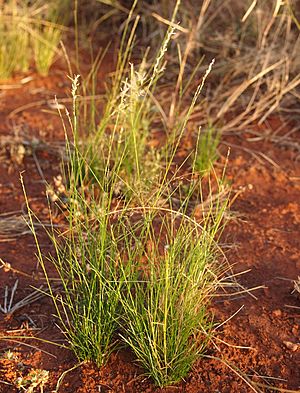Neverfail grass facts for kids
Quick facts for kids Neverfail grass |
|
|---|---|
 |
|
| Scientific classification | |
| Genus: |
Eragrostis
|
| Species: |
setifolia
|
Eragrostis setifolia, also known as neverfail grass, is a special type of grass. It grows naturally in Australia. This grass is a perennial, which means it lives for many years. It's also a C4 grass, meaning it's very good at growing in warm, sunny places.
You can find neverfail grass all over the rangelands of Australia. It's quite common there. Farmers often use it to feed their livestock, like cattle and sheep. Most of the time, this grass is not in danger. But in the state of Victoria, it is considered a vulnerable species.
Contents
What is Neverfail Grass?
Neverfail grass belongs to a large group of grasses called Eragrostis. This group has about 350 different kinds of grass. It's the biggest group in the Chloridoideae plant family. A scientist named Nathanael Matthaeus von Wolf first described the Eragrostis group in 1776. Later, in 1843, another scientist named Nees officially named Eragrostis setifolia as its own species.
How Neverfail Grass Looks
Neverfail grass grows in upright clumps, like a small bush. It can grow up to 60 cm (24 in) tall. But usually, it's between 10 and 50 cm high. This grass has a small underground stem called a rhizome. It helps the plant form a tight clump.
The leaves of neverfail grass are often rough. They are usually about 4–13 cm long. They roll up and get thinner towards the end. The main stems of the grass are covered by wide leaf bases.
The flowers of this grass grow in dense, pointed clusters. These clusters are about 3–12 cm long and 1.5–3 cm wide. The flowers can be pale or light purple. They grow on short branches, up to 3 cm long. Each flower cluster has 10 to 50 tiny flower parts called spikelets. These spikelets are about 2 cm long and 1.5 cm wide. The seeds are very small, weighing only about 0.08 mg each.
Where Neverfail Grass Grows
Neverfail grass is native to Australia. It is very common in the dry, central parts of the country. You can find it in all mainland Australian states. It grows most densely in western New South Wales, South Australia, and the Northern Territory.
This grass often grows in dry woodlands and shrublands. This includes areas with Coolibah and black box trees. It also grows in salt bush communities. Neverfail grass is also a common part of native grasslands, like Mitchell grasslands.
It grows best in places that get a bit more moisture. You'll often find it in low-lying areas. It especially likes land that gets flooded sometimes, such as floodplains. Neverfail grass grows best in clay soils. These soils can be red, brown, grey, or black. Clay soils hold a lot of water, which the grass needs. It's less common in sandy areas. However, it can grow in sandy or loamy soils if they get flooded. Sometimes, it even grows in salty or chalky soils. Neverfail grass can also grow well in soils that don't have many nutrients.
How Neverfail Grass Lives and Its Uses
Neverfail grass is a summer-growing plant. This means it grows actively during the warmer months. It can produce flowers and seeds all year round. The grass grows, sprouts, and flowers when it rains. It needs enough water to germinate, or start growing from a seed.
This grass is very good at handling dry times. It might look like it's dying during severe droughts. But it will grow back when the rain returns. Neverfail grass also seems to grow easily in areas that have been burned. For example, it can grow in burnt spinifex grasslands.
Native animals, like kangaroos, often eat neverfail grass. Red kangaroos especially like to graze on it. For humans, its main use is as food for livestock. Neverfail grass is tough and grows well. This makes it a valuable plant for feeding farm animals. It can handle being grazed better than some other native grasses. It can survive grazing pressure that would kill other grasses. Besides being food, it also provides important habitat for native animals. For example, the plains rat (Pseudomys australis) uses it for shelter.

